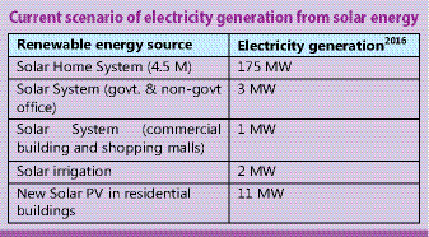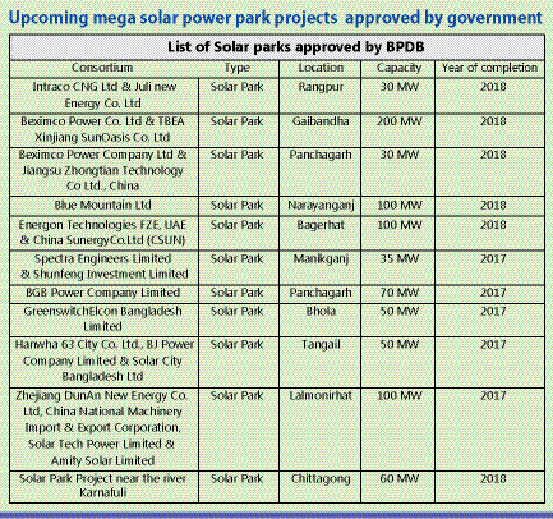 Bangladesh is rich with many natural resources that can be used in alternative power generation and they are in use today at a very modest level-solar and wind energy. Bangladesh has a daily solar irradiation exceeding 4.0 kWh per square metres and in the coastal region a substantial amount of wind resources. Also, Bangladesh has a coastal line of 580km with many windy areas that can be used in both onshore and offshore wind power generation. Solar energy is getting popular mainly in the rural areas as it is cheaper, cleaner and more reliable in the long run than kerosene and village generators. Currently the largest supply of solar energy of around 175 MW is coming from off-grid solar home systems covering more than 10 cities across the country. According to the Sustainable and Renewable Energy Development Authority (SREDA), the newest member of power-cell which was formed in 2012, the contribution of renewable energy is only nearly 1.0 per cent, though the renewable energy policy 2008 is targeting contribution up to 10 per cent of the total power generation by 2020. On the other hand, the overall power generation growth of 10 per cent year on year indicates that the power contribution has to exceed 2000MW from renewable energy by 2020. Many power experts termed this slightly an overambitious vision, but the government is working relentlessly to fulfill their commitment to the people of Bangladesh. Currently approximately 550 MW electricity is coming from renewable sources where 25 million (2.5 crore) consumers consume over 9500 MW of electricity every day. In the breakdown table on renewable energy the contribution from Biogas, Biomass and Wind is very negligible, close to 5.0 MW. However, solar and hydro-power plants are playing a key role here, though hydro-electricity generation is constant, as we have only one power plant, namely "Kaptai Hydro Power Plant" built in 1988.
Bangladesh is rich with many natural resources that can be used in alternative power generation and they are in use today at a very modest level-solar and wind energy. Bangladesh has a daily solar irradiation exceeding 4.0 kWh per square metres and in the coastal region a substantial amount of wind resources. Also, Bangladesh has a coastal line of 580km with many windy areas that can be used in both onshore and offshore wind power generation. Solar energy is getting popular mainly in the rural areas as it is cheaper, cleaner and more reliable in the long run than kerosene and village generators. Currently the largest supply of solar energy of around 175 MW is coming from off-grid solar home systems covering more than 10 cities across the country. According to the Sustainable and Renewable Energy Development Authority (SREDA), the newest member of power-cell which was formed in 2012, the contribution of renewable energy is only nearly 1.0 per cent, though the renewable energy policy 2008 is targeting contribution up to 10 per cent of the total power generation by 2020. On the other hand, the overall power generation growth of 10 per cent year on year indicates that the power contribution has to exceed 2000MW from renewable energy by 2020. Many power experts termed this slightly an overambitious vision, but the government is working relentlessly to fulfill their commitment to the people of Bangladesh. Currently approximately 550 MW electricity is coming from renewable sources where 25 million (2.5 crore) consumers consume over 9500 MW of electricity every day. In the breakdown table on renewable energy the contribution from Biogas, Biomass and Wind is very negligible, close to 5.0 MW. However, solar and hydro-power plants are playing a key role here, though hydro-electricity generation is constant, as we have only one power plant, namely "Kaptai Hydro Power Plant" built in 1988.
 According to the SREDA energy efficiency master database, more than 4.5 million solar home systems (SHSs), 691 solar irrigation systems and 152 solar drinking water systems have been installed throughout the country. IDCOL is playing a significant role in this SHS installation mega work, as these 4.5 million SHSs have saved 1.41 million tonnes of kerosene so far. The project has been claimed to have been the largest off-grid renewable energy programme in the world. A diesel generator costs about Tk 3,000 (USD $38) a month to light a three-room house where a solar home system costs Tk 1,255 (USD $17) in monthly installments after a down payment on a loan that pays off within two hours. But the future of solar power is not the off-grid SHS anymore when the government has decided to build 10 on-grid mega solar parks across the country by 2020. The demand for clean energy is rising, but the main conclusion is that the development of infrastructure and technical backend is currently at a crossroads. The overambitious task of building this solar park depends on the success rate where public and private players and the third sector have to overcome many barriers such as delayed and complex land acquisition, scarcity of skilled manpower, lengthy bureaucratic system etc. Over 85 per cent of the solar energy will be produced by these solar parks and the Bangladesh Power Development Board (BPDP) has contracted seven Independent Power Producers (IPP) contracts through an unsolicited project process. Here we see the big challenge. Five out of seven producers have faced disruption in plant land acquisition. Therefore, no satisfactory development was seen in this regard despite giving permission to many IPPs and entrepreneurs to produce electricity from renewable energy. The quick process of giving permission under the speedy supply of power and energy (Special Provision) Act 2010 to build plants seems not that much speedy at all. The following list contains the permitted solar parks which were supposed to be in operation by 2018, but not a single plant could be built till date.
According to the SREDA energy efficiency master database, more than 4.5 million solar home systems (SHSs), 691 solar irrigation systems and 152 solar drinking water systems have been installed throughout the country. IDCOL is playing a significant role in this SHS installation mega work, as these 4.5 million SHSs have saved 1.41 million tonnes of kerosene so far. The project has been claimed to have been the largest off-grid renewable energy programme in the world. A diesel generator costs about Tk 3,000 (USD $38) a month to light a three-room house where a solar home system costs Tk 1,255 (USD $17) in monthly installments after a down payment on a loan that pays off within two hours. But the future of solar power is not the off-grid SHS anymore when the government has decided to build 10 on-grid mega solar parks across the country by 2020. The demand for clean energy is rising, but the main conclusion is that the development of infrastructure and technical backend is currently at a crossroads. The overambitious task of building this solar park depends on the success rate where public and private players and the third sector have to overcome many barriers such as delayed and complex land acquisition, scarcity of skilled manpower, lengthy bureaucratic system etc. Over 85 per cent of the solar energy will be produced by these solar parks and the Bangladesh Power Development Board (BPDP) has contracted seven Independent Power Producers (IPP) contracts through an unsolicited project process. Here we see the big challenge. Five out of seven producers have faced disruption in plant land acquisition. Therefore, no satisfactory development was seen in this regard despite giving permission to many IPPs and entrepreneurs to produce electricity from renewable energy. The quick process of giving permission under the speedy supply of power and energy (Special Provision) Act 2010 to build plants seems not that much speedy at all. The following list contains the permitted solar parks which were supposed to be in operation by 2018, but not a single plant could be built till date.
 The government of Bangladesh has approved a total of 18 solar project proposals under the "No electricity No payment" policy for building nationwide solar parks that would add more than 1050 MW of electricity by the end of 2017, but none of them could finish infrastructure development yet. The reason behind the lengthy lead time is: large-sized solar power plants need a big area of land for installing solar panels, but in Bangladesh such barren field is hardly available. Recently, energy experts from SREDA have identified a shortage of uncultivated land in the densely-populated country as a significant constraint to setting up of large-scale solar plants. The policy is to set up solar parks only on non-agricultural land to keep food production unhampered. On-grid solar park projects have seen slower growth in terms of infrastructure development due to scarcity of land. Many experts have suggested proper scrutiny into technical feasibility before awarding mega solar projects to new consortiums and entrepreneurs to achieve the clean energy vision. If these can be done prudently, Bangladesh will top the list of green energy countries by 2041.
The government of Bangladesh has approved a total of 18 solar project proposals under the "No electricity No payment" policy for building nationwide solar parks that would add more than 1050 MW of electricity by the end of 2017, but none of them could finish infrastructure development yet. The reason behind the lengthy lead time is: large-sized solar power plants need a big area of land for installing solar panels, but in Bangladesh such barren field is hardly available. Recently, energy experts from SREDA have identified a shortage of uncultivated land in the densely-populated country as a significant constraint to setting up of large-scale solar plants. The policy is to set up solar parks only on non-agricultural land to keep food production unhampered. On-grid solar park projects have seen slower growth in terms of infrastructure development due to scarcity of land. Many experts have suggested proper scrutiny into technical feasibility before awarding mega solar projects to new consortiums and entrepreneurs to achieve the clean energy vision. If these can be done prudently, Bangladesh will top the list of green energy countries by 2041.
Omor Ahmed is former planning engineer of a leading telco, currently working for Inspira Advisory and Consulting Ltd. He is also a community leader empowering the ICT ecosystem by connecting local developers and youths with international platforms. [email protected]
© 2024 - All Rights with The Financial Express
